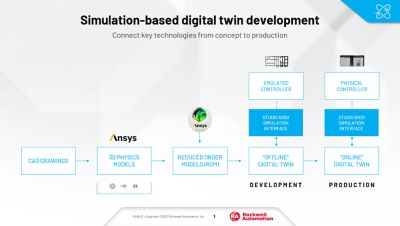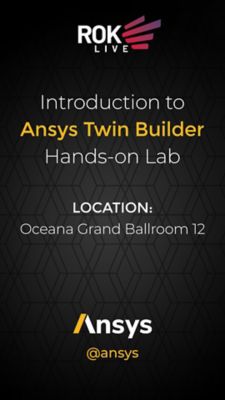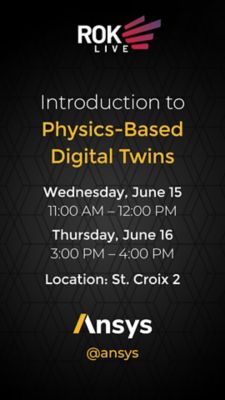-
-
Access Free Student Software
Ansys empowers the next generation of engineers
Students get free access to world-class simulation software.
-
Connect with Ansys Now!
Design your future
Connect with Ansys to explore how simulation can power your next breakthrough.
Countries & Regions
Free Trials
Products & Services
Learn
About
Back
Products & Services
Back
Learn
Ansys empowers the next generation of engineers
Students get free access to world-class simulation software.
Back
About
Design your future
Connect with Ansys to explore how simulation can power your next breakthrough.
Free Trials
ANSYS BLOG
June 9, 2022
Deploy Your Digital Twin as a Runtime in Rockwell Automation’s Studio 5000 Simulation Interface
Ansys and Rockwell Automation improve the design, deployment, and performance of industrial operations.
Rockwell Automation Studio 5000 Simulation Interface connects to Ansys Twin Builder, enabling engineering teams to implement simulation-based digital twins by unlocking an extensive range of insights that can improve system design, performance, and maintenance of your assets in operation.
But, how does it work and what will you gain?
Leverage Simulation-Based Digital Twins with Reduced-Order Modeling (ROM) Technology
Simulation-based digital twin technology from Ansys enables engineers to implement complete virtual prototypes of real-world systems. Users can test process changes (i.e., material, power energy, environmental conditions, etc.) before it is implemented on the physical asset. This enables engineering teams to improve throughput and other aspects of performance of the in-operation asset.
Predictive maintenance, supported by simulation-based digital twins, enables users to calculate the remaining life of equipment and plan for maintenance, reducing the chance of costly unplanned downtime. This is the power of ROM technology enabled by Ansys Twin Builder.
Environmental and material effects like flow rates, mechanical stresses, and thermal profiles impact in-field assets. By combining multiphysics simulation of your system models, 3D physics models, and recorded data of your asset, you can create a ROM of your system to reduce simulation time from hours to milliseconds. The simulation-based digital twin can then be exported as a ROM to be deployed in Studio 5000 Simulation Interface.
Deploy Your Digital Twin as a Runtime in Rockwell Automation’s Studio 5000 Simulation Interface
By connecting your simulation-based digital twin to Rockwell Automation’s Studio 5000 Simulation Interface at design time, or in operation on an edge computing device, engineers can simulate complex and detailed physical phenomena and better understand their asset in-operation.

Getting the virtual replica connected to an in-service physical asset, thanks to runtime technology, gives the users realistic inputs of what is going in the control system of their installation, in real-time. This enables predictive maintenance or optimization of control code by continually comparing the model to the actual production.
By deploying your simulation-based digital twin as a runtime in Studio 5000 Simulation Interface, you can bridge the digital and physical worlds. The exported simulation-based digital twin from Ansys Twin Builder enables users to run their digital twin to:
- Test and predict equipment behavior
- Perform what-if scenarios
- Predict operational issues
To see a live demo of deploying a simulation-based digital twin with Ansys Twin Builder in Rockwell Automation’s Studio 5000 Simulation Interface, join us at ROKLive, on June 13-16 in Orlando, Florida.
Our team will present:
- Introduction to Ansys Twin Builder Hands-On Lab:
- Location: Oceana Grand Ballroom 12
- June 14: 11 a.m. - 1 p.m. ET and 4 - 6 p.m. ET
- June 15: 9 - 11 a.m. ET and 2 - 4 p.m. ET
- June 16: 11 a.m. - 1 p.m. ET and 4 - 6 p.m. ET
- Location: Oceana Grand Ballroom 12
- Introduction to Physics-Based Digital Twin
- Location: St. Croix 2
- June 15: 11 a.m. - Noon ET
- June 16: 3 - 4 p.m. ET
- Location: St. Croix 2


